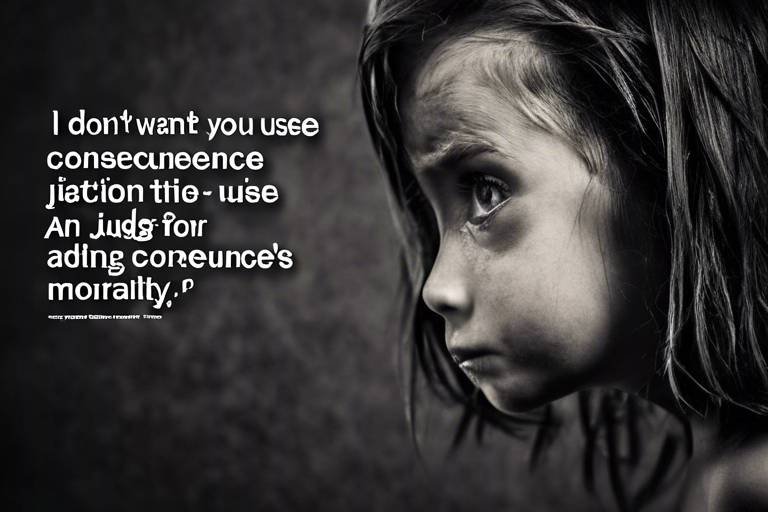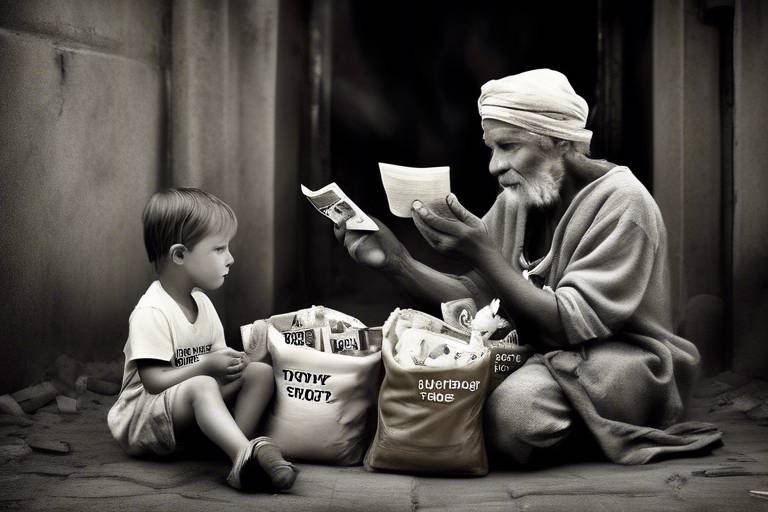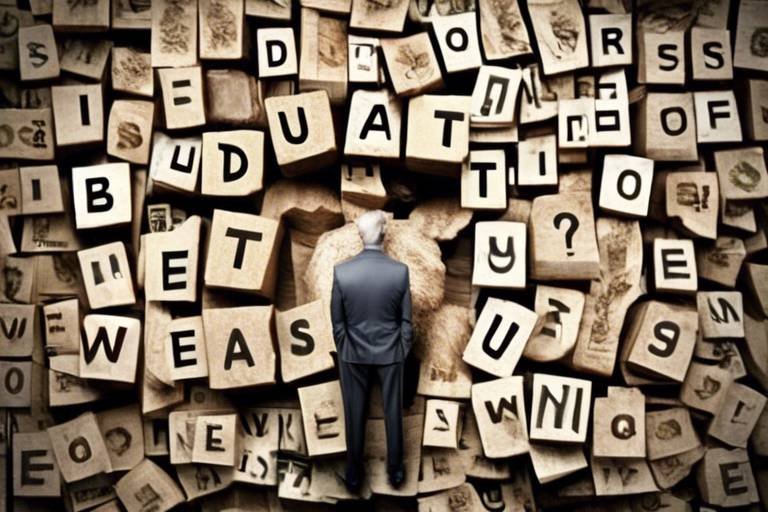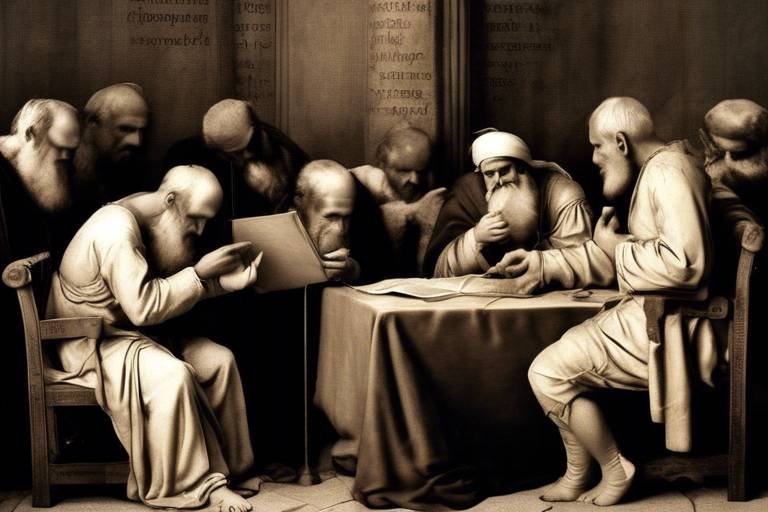The Morality of Censorship in the 21st Century
Censorship is a topic that has sparked heated debates throughout history, but in the 21st century, its implications have become more complex than ever. With the rise of the internet and social media, the way we communicate has drastically changed, making the conversation around censorship not just relevant but essential. Today, we must ask ourselves: What are the ethical boundaries of censorship? Are we protecting society, or are we stifling free expression? This article delves into the ethical implications of censorship, examining its impact on freedom of expression, societal norms, and the delicate balance between protecting individuals and upholding democratic values.
To truly understand the moral dilemmas surrounding censorship today, we need to look back at its history. Censorship isn’t a new concept; it has been a tool for governments and institutions for centuries. From the burning of books in ancient civilizations to the suppression of dissent in totalitarian regimes, history is rife with examples that have shaped our current perceptions of censorship. For instance, during the McCarthy era in the United States, fear led to the suppression of artistic expression and political dissent, showcasing how censorship can be wielded as a weapon against freedom. By examining these historical instances, we can better understand the moral complexities we face today.
Fast forward to the present, and we find ourselves in an age where technology plays a pivotal role in how censorship is enacted. The internet has become a double-edged sword; while it offers a platform for free expression, it also enables the rapid spread of harmful content. Social media giants like Facebook and Twitter are constantly grappling with the challenge of moderating content while respecting user rights. This raises a critical question: How do we regulate online content without infringing on freedom of speech? The ethical challenges of regulating online content are compounded by the speed at which information travels and the global nature of the internet. Moreover, algorithms that determine what content is visible can inadvertently perpetuate biases, leading to further ethical dilemmas.
One of the most contentious issues in the realm of censorship is finding the right balance between freedom of expression and protecting individuals from harm. On one hand, we have the right to express our thoughts and opinions; on the other, we must consider the potential consequences of those expressions. For instance, hate speech can lead to violence and discrimination, prompting calls for censorship to protect vulnerable communities. However, this raises the question: Where do we draw the line? The moral considerations involved in restricting speech are complex, and the potential consequences of censorship can be far-reaching. Striking a balance that protects individuals while preserving freedom of expression is a challenging, yet necessary, endeavor.
The debate surrounding hate speech is central to discussions of censorship. While many argue that censoring hate speech is necessary to protect marginalized groups, others contend that such censorship can lead to a slippery slope of overreach. For example, what one person views as hate speech, another may see as a legitimate opinion. This subjectivity complicates the ethical implications of censoring hateful content. As we navigate this terrain, we must consider the potential for abuse and the importance of context in determining what should be censored. The challenge lies in creating a framework that addresses the harms of hate speech without infringing on free expression.
Censorship has a profound impact on societal values and norms. It shapes public discourse and influences cultural narratives, often dictating what is deemed acceptable or taboo. When certain ideas or expressions are censored, it creates a chilling effect where individuals may self-censor out of fear of repercussions. This not only stifles creativity and innovation but also limits the diversity of thought within society. As we consider the implications of censorship, we must ask ourselves: What kind of society do we want to create? A society that embraces open dialogue and diverse perspectives is essential for a thriving democracy.
Censorship practices vary widely across the globe, influenced by cultural, political, and historical factors. In some countries, censorship is a tool for authoritarian regimes to maintain control, while in others, it is used to uphold societal values. For instance, countries like North Korea and China employ strict censorship to suppress dissent, whereas Western democracies grapple with the complexities of regulating hate speech and misinformation. Understanding these diverse approaches to censorship highlights the ethical implications and the need for a nuanced discussion that respects cultural differences while advocating for universal human rights.
As society continues to evolve, so do the challenges surrounding censorship. Emerging trends, such as the rise of artificial intelligence and the increasing role of social media in shaping public opinion, present new ethical dilemmas. We must consider how these developments will influence the future of censorship and the ongoing moral debates that will shape its trajectory. Will we find a way to balance the need for regulation with the imperative of preserving free expression? The answers remain uncertain, but one thing is clear: the conversation around censorship is far from over.
Analyzing specific instances of censorship can illuminate its moral complexities. For example, consider the case of Charlie Hebdo, where the publication faced violent backlash for its satirical cartoons. This incident raises questions about the limits of satire and the responsibilities of creators. By examining such case studies, we can better understand the nuances of censorship and the ethical dilemmas faced by individuals and institutions.
- What is censorship? Censorship is the suppression of speech, public communication, or other information that may be considered objectionable, harmful, or sensitive.
- Is censorship ever justified? While some argue that censorship is necessary to protect individuals and maintain societal order, others believe it often infringes on fundamental rights.
- How does technology influence censorship? The internet and social media have transformed censorship, making it more complex and challenging to regulate while also providing platforms for free expression.
- What are the ethical implications of censoring hate speech? Censoring hate speech raises questions about free expression and the potential for abuse, making it a contentious issue in discussions of censorship.

The Historical Context of Censorship
Understanding the roots of censorship is like peeling an onion; each layer reveals deeper complexities and historical nuances. Censorship has existed in various forms throughout human history, often intertwined with the prevailing political, cultural, and social dynamics of the time. From ancient empires to modern democracies, the practice of controlling information has been a powerful tool wielded by authorities to maintain order, suppress dissent, and shape public perception.
In ancient times, rulers often employed censorship to control the narrative and consolidate their power. For instance, the Roman Empire famously censored texts that criticized the government or its leaders. Similarly, in the Middle Ages, the Catholic Church established the Index Librorum Prohibitorum, a list of prohibited books that aimed to protect the faithful from heretical ideas. This illustrates how censorship was not just a means of control but also a way to uphold certain moral or religious standards.
Fast forward to the 20th century, and we see censorship taking on new forms with the advent of mass media. The rise of totalitarian regimes such as Nazi Germany and Stalinist Russia showcased the extreme lengths to which governments would go to suppress free speech. Propaganda was rampant, and any dissenting voices were silenced, often with brutal consequences. These historical examples serve as stark reminders of the potential dangers of unchecked censorship and the moral dilemmas it presents.
As we navigate through the complexities of censorship today, it’s essential to recognize that its historical context shapes our current understanding. Here are some pivotal moments in the evolution of censorship:
| Time Period | Event | Impact |
|---|---|---|
| Ancient Rome | Suppression of dissenting literature | Control over public opinion |
| Middle Ages | Index Librorum Prohibitorum established | Protection of religious doctrine |
| 20th Century | Nazi and Soviet censorship | Mass suppression of free speech |
| 21st Century | Digital censorship and regulation | New ethical challenges in free expression |
The transition from traditional forms of censorship to digital censorship marks a significant shift in how information is controlled. Today, platforms like social media have become battlegrounds for free speech, where the lines between censorship and moderation often blur. The historical context provides a crucial lens through which we can examine these modern challenges, reminding us that while the tools of censorship may change, the ethical implications remain profoundly relevant.
Ultimately, the history of censorship is a tapestry woven with threads of power, control, and the struggle for freedom. Each era has faced its unique challenges, but the fundamental questions about the morality of censorship persist. How do we protect individuals while upholding the principles of free expression? As we delve deeper into this topic, we must reflect on the lessons of the past to navigate the complexities of censorship in our current society.

The Role of Technology in Censorship
In the digital age, technology plays a pivotal role in shaping how we experience censorship. Gone are the days when censorship was merely a matter of books being burned or newspapers being shut down. Today, we find ourselves navigating a complex web of information where the power to censor is often just a click away. But what does this mean for freedom of expression? Can we truly protect ourselves from harmful content without infringing on our rights?
To understand the impact of technology on censorship, we first need to consider the rise of social media platforms and their influence on public discourse. Platforms like Facebook, Twitter, and Instagram have revolutionized how we communicate, allowing users to share their thoughts and opinions with a global audience. However, this democratization of information also raises significant challenges. For instance, how do these platforms decide what content to remove? And who gets to define what is considered harmful or inappropriate?
Many tech companies have implemented algorithms to monitor and regulate content. These algorithms are designed to identify and filter out hate speech, misinformation, and other harmful content. While this sounds like a noble endeavor, the reality is often more complicated. Algorithms can be biased, leading to the unintended suppression of legitimate discourse. For example, a post discussing a controversial political issue might be flagged as hate speech simply because it includes certain keywords, regardless of the context. This can create a chilling effect, where individuals hesitate to express their views for fear of being censored.
Moreover, the role of government regulations cannot be overlooked. Various countries have enacted laws that require tech companies to take down specific content, often in the name of national security or public safety. This creates a precarious balance between protecting citizens and infringing on individual rights. The table below outlines some notable examples of government regulations affecting online content:
| Country | Regulation | Impact |
|---|---|---|
| China | Great Firewall | Extensive censorship of foreign websites and platforms |
| Germany | NetzDG | Fines for platforms failing to remove hate speech |
| United States | Section 230 | Liability protections for online platforms |
As we delve deeper into the role of technology in censorship, we must also consider the implications of user-generated content. The rise of platforms like YouTube and TikTok allows individuals to create and share content without the traditional gatekeeping of media outlets. However, this freedom comes with its own set of challenges. Content creators may face backlash or even censorship from both the platform and the audience for expressing unpopular opinions. The question then arises: how do we navigate this new landscape where everyone has a voice, yet some voices are silenced?
In conclusion, the role of technology in censorship is multifaceted and constantly evolving. As we continue to embrace digital platforms, we must remain vigilant about the ethical implications of censorship practices. Striking a balance between protecting individuals from harm and preserving freedom of expression is no easy feat. It requires ongoing dialogue and critical examination of the tools and regulations that shape our online experiences. So, as we scroll through our feeds, let’s ask ourselves: are we truly free to express our thoughts, or are we just navigating a minefield of censorship?
- What is the main purpose of censorship in the digital age? Censorship aims to protect individuals from harmful content while maintaining societal norms and values.
- How do social media platforms determine what content to censor? They often use algorithms and community guidelines, but these can be biased and lead to unintended consequences.
- What are the potential risks of government regulation of online content? Government regulations can infringe on freedom of expression and lead to overreach, stifling legitimate discourse.
- How can individuals protect themselves from censorship? Being aware of platform policies, advocating for transparency, and choosing diverse sources of information can help mitigate censorship effects.

The Balance Between Freedom and Protection
When we talk about censorship, the conversation often revolves around a central tension: the delicate balance between freedom of expression and the need to protect individuals and society as a whole. It’s a bit like walking a tightrope—one misstep can lead to a fall on either side. On one hand, we cherish our freedom to speak, express, and share ideas without fear of retribution. On the other hand, there’s a growing concern about the potential harm that unchecked speech can inflict on vulnerable individuals or communities. So, how do we navigate this tricky terrain?
To start, it's crucial to understand that freedom of expression is a cornerstone of democratic societies. It allows for the exchange of ideas, fosters innovation, and enables social progress. However, this freedom is not absolute. Just like how we have laws against shouting "fire" in a crowded theater, there are limits to what can be said or published. The challenge lies in defining where those limits should be drawn. Who gets to decide what constitutes harmful speech? And can we trust those in power to make these decisions fairly?
One might argue that the very act of censoring speech can lead to a slippery slope, where the boundaries of what is considered "harmful" are continuously pushed. For instance, consider social media platforms that have implemented strict guidelines to curb hate speech. While the intention is noble—protecting individuals from verbal abuse and discrimination—the implementation can sometimes lead to the suppression of legitimate discourse. This is where the ethical dilemma intensifies. Are we sacrificing our freedom for the sake of protection? Or are we simply ensuring that our society remains a safe space for all?
Moreover, the impact of censorship varies across different demographics. For example, marginalized communities often bear the brunt of both hate speech and censorship. While they may benefit from protective measures, they can also find their voices stifled in the process. This creates a paradox where the very tools established to protect can inadvertently silence those who need to be heard the most. It’s a complex interplay that demands careful consideration and constant dialogue.
In navigating this balance, we must also consider the role of technology. With the rise of digital platforms, the landscape of expression has changed dramatically. Algorithms that determine what content is visible can inadvertently favor certain viewpoints over others, leading to a form of censorship that is less about morality and more about profit and engagement metrics. As we become increasingly reliant on these platforms for communication, the question arises: who holds the power to shape our discourse?
Ultimately, finding the right balance between freedom and protection is an ongoing challenge. It requires a commitment to open dialogue, where diverse perspectives can be shared without fear of censorship. It also demands that we hold those in positions of power accountable for their decisions regarding what speech is deemed acceptable. The aim should be to cultivate an environment where individuals feel safe to express themselves while also being protected from harm.
As we move forward, it’s essential to foster a culture of understanding and respect. We must engage in conversations that are not just about what can or cannot be said, but also about the impact of those words on our society. Only then can we hope to strike a balance that honors both our freedoms and our responsibilities.
- What is the main issue with censorship today?
Censorship today grapples with the challenge of balancing freedom of expression with the need to protect individuals from harmful speech. - How does technology influence censorship?
Technology, especially social media, has transformed censorship practices by enabling rapid dissemination of information and creating new ethical dilemmas regarding content regulation. - Can censorship ever be justified?
While censorship can be justified in cases of hate speech or incitement to violence, it is essential to ensure that it does not infringe on legitimate discourse. - What role do marginalized communities play in discussions of censorship?
Marginalized communities often face unique challenges regarding censorship, as protective measures can sometimes silence their voices while aiming to protect them.

Censorship and Hate Speech
The debate surrounding hate speech is at the forefront of discussions about censorship, and it brings with it a whirlwind of ethical considerations. Hate speech, defined as any form of communication that incites violence or prejudicial action against a particular group based on attributes such as race, religion, or sexual orientation, poses a unique challenge to the principles of free speech. On one hand, we cherish our right to express ourselves—our thoughts, opinions, and beliefs. But on the other hand, we must grapple with the very real consequences that arise when those expressions morph into harmful rhetoric.
Imagine a world where every word spoken is carefully monitored, where the fear of censorship stifles creativity and honest discourse. This is one extreme. Conversely, picture a society where hate speech runs rampant, leading to violence and division. This is another extreme. The challenge lies in finding a middle ground that respects both freedom of expression and the need to protect individuals from harm.
Many argue that censoring hate speech is necessary to maintain social harmony and protect vulnerable communities. In fact, numerous countries have enacted laws to limit hate speech, reflecting a global trend towards prioritizing societal well-being over unbridled free speech. However, these laws can often be a double-edged sword. The potential for abuse and overreach is significant, as governments or organizations may exploit these regulations to silence dissenting voices, labeling them as hate speech when they are, in fact, legitimate critiques.
To better understand this complex relationship, consider the following table that outlines different perspectives on hate speech and censorship:
| Perspective | Argument For Censorship | Argument Against Censorship |
|---|---|---|
| Legal | Protects marginalized groups from harm. | May infringe on fundamental rights. |
| Social | Promotes a more inclusive society. | Stifles open dialogue and debate. |
| Political | Prevents the rise of extremist ideologies. | Can be used as a tool for political oppression. |
This table illustrates the ongoing tug-of-war between the necessity of protecting individuals and the fundamental right to free speech. The consequences of censorship, especially when it comes to hate speech, can ripple through society, shaping not only public discourse but also individual beliefs and behaviors.
Moreover, the challenge becomes even more pronounced in the digital age. Social media platforms, while providing a space for free expression, also serve as breeding grounds for hate speech. The algorithms that govern these platforms often prioritize engagement over ethics, allowing harmful content to proliferate. This raises the question: how do we hold these platforms accountable while ensuring that they do not overreach in their efforts to control content?
In conclusion, the issue of censorship and hate speech is a complex moral dilemma that requires careful consideration. As we navigate this landscape, we must remain vigilant, advocating for a balanced approach that protects individuals without compromising the very freedoms we hold dear.
- What is hate speech? Hate speech refers to any form of communication that incites violence or prejudicial action against a particular group based on attributes such as race, religion, or sexual orientation.
- Is all hate speech subject to censorship? Not all hate speech is censored; laws vary by country, and the context in which words are spoken can influence whether they are deemed harmful.
- How do social media platforms handle hate speech? Many social media platforms have policies in place to combat hate speech, but enforcement can be inconsistent and controversial.
- Can censoring hate speech lead to more harm? Yes, there is a risk that censoring hate speech could lead to the suppression of legitimate dissent and criticism.

The Impact of Censorship on Society
Censorship is like a double-edged sword; it can protect society from harmful content while simultaneously stifling creativity and free thought. In the 21st century, the ramifications of censorship extend far beyond mere restrictions on speech. They ripple through the very fabric of society, shaping public discourse, influencing cultural narratives, and even impacting individual beliefs and behaviors. Have you ever considered how the things we are not allowed to say or see might affect our worldview? It’s a profound question that deserves our attention.
One of the most significant impacts of censorship is its ability to alter societal norms. When certain topics are deemed too controversial or sensitive to discuss openly, it creates a culture of silence around those issues. For instance, discussions about mental health, sexuality, and political dissent often face censorship, which can lead to a lack of understanding and empathy within society. People may feel isolated or misunderstood, as they are unable to express their thoughts or experiences. This can foster a sense of alienation, making individuals feel like they are living in a society that doesn't acknowledge their reality.
Moreover, censorship can shape cultural narratives in profound ways. When media outlets or social platforms censor specific viewpoints, it can create an echo chamber where only certain perspectives are amplified. This can skew public perception and create a false sense of consensus around issues that are, in reality, much more complex. For example, the way news organizations choose to report on protests or controversial legislation can influence how society views these events. If dissenting voices are silenced, the public may be left with an incomplete understanding of the issues at hand, leading to misguided opinions and actions.
Furthermore, the impact of censorship isn't just limited to public discourse; it can also influence individual behavior. When people perceive that certain topics are taboo or dangerous to discuss, they may internalize these beliefs, leading to self-censorship. This phenomenon can stifle creativity and innovation, as individuals may be less likely to express radical or unconventional ideas. Imagine a world where artists, writers, and thinkers are afraid to push boundaries for fear of backlash. The potential for societal growth and evolution is significantly hampered in such an environment.
To illustrate the impact of censorship on society, consider the following table that summarizes the potential effects:
| Type of Censorship | Potential Impact on Society |
|---|---|
| Political Censorship | Suppression of dissenting opinions, leading to a lack of accountability in governance. |
| Media Censorship | Skewed narratives that distort public perception and understanding of events. |
| Self-Censorship | Stifling of creativity and innovation, as individuals refrain from expressing controversial ideas. |
| Social Censorship | Creation of stigmas around certain topics, leading to isolation and misunderstanding. |
In conclusion, the impact of censorship on society is multifaceted and complex. It can protect individuals from harmful content, but it also has the potential to create a culture of silence and misunderstanding. As we navigate the challenges of the 21st century, it is essential to critically evaluate the implications of censorship and strive for a balance that upholds both freedom of expression and the need for societal protection. After all, a society that encourages open dialogue and diverse perspectives is one that is more likely to thrive and evolve.
- What is censorship? Censorship is the suppression or prohibition of speech, public communication, or other information that may be considered objectionable or harmful.
- How does censorship affect freedom of expression? Censorship can limit freedom of expression by preventing individuals from sharing their thoughts, opinions, and ideas openly.
- Are there different types of censorship? Yes, censorship can be political, media-related, self-imposed, or social, each having distinct impacts on society.
- Can censorship ever be justified? While some argue that censorship is necessary to protect individuals from harmful content, many believe it often leads to more harm than good by stifling important conversations.

The Global Perspective on Censorship
Censorship is not a one-size-fits-all phenomenon; it varies dramatically across different cultures and political landscapes. In some countries, censorship is a tool wielded by authoritarian regimes to suppress dissent and control the narrative, while in others, it may be a means of protecting societal values and norms. The ethical implications of these practices can be profound, influencing everything from individual rights to international relations.
In places like North Korea, censorship is absolute. The government controls all media, and any dissenting voice is quashed. Citizens are not only denied access to outside information but are also subjected to severe punishments for even minor infractions. This extreme form of censorship raises significant moral questions: is it justifiable to protect a regime's power at the expense of individual freedom? The answer, for many, is a resounding no. The human cost of such repression is immeasurable, and the ethical implications are staggering.
Conversely, in countries like Sweden, censorship is minimal, with a strong emphasis on freedom of expression. Here, the belief is that open dialogue and debate are fundamental to a healthy society. However, even in Sweden, there are discussions about the limits of free speech, especially when it comes to hate speech or misinformation. This raises the question: how do we protect individuals while also upholding the principles of democracy? It's a delicate balance, and one that societies around the world are grappling with.
To illustrate the diversity of censorship practices globally, we can look at a few key examples:
| Country | Censorship Type | Key Issues |
|---|---|---|
| North Korea | Government Control | Suppression of dissent, information blackout |
| China | Internet Censorship | Great Firewall, control over social media |
| United States | Self-Censorship | Political correctness, cancel culture |
| Germany | Regulated Speech | Hate speech laws, historical context |
This table highlights how censorship can take many forms, each with its own ethical considerations. For instance, while China's internet censorship aims to maintain social stability, it also stifles innovation and free thought. In contrast, the U.S. faces challenges with self-censorship, where societal pressures can lead individuals to refrain from expressing their true opinions, thus limiting the richness of public discourse.
Moreover, the global perspective on censorship is also shaped by international human rights laws. The Universal Declaration of Human Rights states that everyone has the right to freedom of opinion and expression. However, the implementation of these rights varies significantly. In some regions, governments prioritize security over freedom, leading to a troubling trend of increasing censorship under the guise of protecting citizens. This brings us to the question: can we truly call ourselves free if our voices are silenced?
As we navigate through this complex landscape, it's clear that the global perspective on censorship is not just about laws and regulations; it's about the values we hold as a society. The ongoing debates around censorship are a reflection of our collective conscience, pushing us to reconsider what it means to be free in an interconnected world. As we move forward, we must remain vigilant, advocating for a balance between protecting individuals and preserving the fundamental rights that underpin democratic societies.
- What is censorship? Censorship is the suppression or prohibition of speech, public communication, or other information that may be considered objectionable or harmful.
- Why is censorship a moral issue? Censorship raises ethical questions about the balance between protecting individuals and upholding freedom of expression.
- How does technology influence censorship? Technology has changed how information is disseminated and regulated, leading to new challenges in balancing free speech and harmful content.
- What are the consequences of censorship? Censorship can limit public discourse, stifle creativity, and create a culture of fear, impacting society's overall health.

The Future of Censorship
The landscape of censorship is shifting rapidly as we move deeper into the 21st century. With the advent of new technologies and the increasing influence of social media, the way we understand and implement censorship is evolving. The future of censorship isn't just about controlling information; it's about navigating a complex web of ethical dilemmas, technological advancements, and societal expectations. As we look ahead, several key factors will shape the trajectory of censorship practices globally.
One of the most significant influences on the future of censorship is the rise of artificial intelligence (AI) and machine learning. These technologies have the potential to automate the monitoring of online content, making it easier for platforms to identify and remove harmful material. However, this raises important questions about accountability and transparency. If algorithms are making decisions about what content is acceptable, who is responsible for the consequences? Are we willing to trust machines with the moral complexities of human communication?
Moreover, as digital platforms continue to dominate our lives, we must consider the role of corporate interests in censorship. Social media giants like Facebook, Twitter, and YouTube wield enormous power over what information is disseminated. Their policies often reflect their business models rather than a commitment to free speech. This corporate influence can lead to inconsistencies in how censorship is applied, creating a landscape where some voices are amplified while others are silenced. As consumers, we need to be aware of these dynamics and advocate for more equitable practices.
Another crucial element to consider is the growing push for regulatory frameworks that govern online content. Governments around the world are grappling with how to manage the delicate balance between protecting citizens from harmful content and upholding the principles of free expression. While some countries have implemented strict regulations that infringe on freedom of speech, others are taking a more measured approach, seeking to promote digital literacy and responsible online behavior. The future will likely see more countries adopting comprehensive policies that reflect their unique cultural and political contexts.
As we navigate these changes, public sentiment will play a vital role in shaping the future of censorship. The ongoing debates about hate speech, misinformation, and the responsibilities of digital platforms are indicative of a society that is increasingly aware of the implications of censorship. Citizens are demanding greater accountability and transparency from those who control the flow of information. This shift in public consciousness could lead to a more collaborative approach to content regulation, where stakeholders—including governments, tech companies, and civil society—work together to create a balanced framework that respects both freedom of expression and the need for protection.
In conclusion, the future of censorship is not set in stone. It is a dynamic and evolving issue that will require ongoing dialogue and adaptation. As we embrace new technologies and confront emerging challenges, we must remain vigilant about the ethical implications of censorship. By fostering a culture of open discussion and critical thinking, we can ensure that the future of censorship aligns with our democratic values and respects the dignity of all individuals.
- What role does technology play in censorship?
Technology, particularly AI and machine learning, is increasingly being used to monitor and regulate online content, raising questions about accountability and transparency. - How do corporate interests affect censorship?
Corporate interests can influence censorship practices, often prioritizing business models over commitments to free speech, leading to inconsistencies in content regulation. - What is the impact of public sentiment on censorship?
As public awareness of censorship issues grows, citizens are demanding greater accountability from digital platforms, which may lead to more collaborative approaches in content regulation. - Will censorship practices vary globally?
Yes, censorship practices will continue to vary depending on cultural, political, and social contexts, influencing how countries approach content regulation.

Case Studies in Censorship
Censorship is not just a theoretical concept; it manifests in real-world scenarios that often leave us questioning the morality behind such actions. Let's dive into a few compelling case studies that illustrate the complexities of censorship and its ethical implications. One of the most notable examples is the Chinese government's censorship of the internet. This extensive control over online content, often referred to as the "Great Firewall of China," restricts access to foreign websites, social media platforms, and even search engines. The government justifies this by claiming it protects national security and social harmony. However, the ethical dilemma arises when we consider the impact on freedom of expression and the right to information.
Another striking case is the controversy surrounding the publication of cartoons depicting the Prophet Muhammad. In 2005, a Danish newspaper published these cartoons, leading to widespread protests and calls for censorship in various countries. Supporters of censorship argued that it was necessary to protect religious sentiments, while opponents claimed it infringed upon free speech rights. This case exemplifies the delicate balance between respecting cultural beliefs and upholding democratic values.
In the realm of social media, the de-platforming of controversial figures has sparked heated debates about censorship. For instance, when major platforms like Twitter and Facebook banned former President Donald Trump following the Capitol riots in January 2021, it raised questions about who gets to decide what constitutes harmful speech. While some applauded these actions as necessary to prevent incitement of violence, others viewed it as an alarming precedent for silencing dissenting voices. This case highlights the ethical challenges that arise when private companies wield significant power over public discourse.
To further illustrate these points, consider the following table that summarizes key aspects of each case study:
| Case Study | Type of Censorship | Ethical Implications |
|---|---|---|
| Chinese Internet Censorship | Government Control | Limits freedom of expression; raises questions about human rights |
| Cartoons of Prophet Muhammad | Religious Censorship | Conflict between cultural respect and freedom of speech |
| De-platforming of Trump | Corporate Censorship | Power dynamics in social media; implications for free speech |
These case studies reveal that censorship is rarely black and white; it often exists in shades of gray. The ethical considerations surrounding each instance are complex and multifaceted, raising questions about the values we hold dear in a democratic society. As we navigate through these dilemmas, it's crucial to engage in open dialogue and consider the perspectives of all stakeholders involved.
In conclusion, the study of censorship through these real-world examples not only sheds light on its implications but also encourages us to reflect on our own beliefs about freedom and responsibility. The ongoing discussions surrounding these cases will undoubtedly shape the future of censorship and its moral landscape.
- What is censorship? Censorship is the suppression or prohibition of speech, public communication, or other information that may be considered objectionable or harmful.
- Is censorship ever justified? While some argue that censorship can protect individuals and society, it often raises ethical concerns regarding freedom of expression and human rights.
- How does technology influence censorship? Technology has transformed censorship practices, allowing for both increased control over information and new platforms for free expression.
- What are the consequences of censorship? Censorship can lead to a lack of diversity in public discourse, suppression of dissenting voices, and a culture of fear regarding free speech.
Frequently Asked Questions
- What is censorship, and why does it exist?
Censorship is the suppression or restriction of speech, public communication, or other information. It exists to protect individuals and society from harmful content, maintain public order, and uphold moral standards. However, it also raises questions about freedom of expression and the potential for abuse of power.
- How has technology changed the landscape of censorship?
Technology has dramatically transformed censorship by enabling rapid dissemination of information and creating new platforms for expression. Digital platforms often face challenges in regulating content, leading to ethical dilemmas about what should be censored and the potential for overreach in controlling online speech.
- Is there a way to balance freedom of expression and protection from harm?
Finding a balance between freedom of expression and protecting individuals from harm is complex. It involves considering the context, intent, and potential consequences of speech. Discussions often focus on whether certain types of speech, like hate speech, should be restricted to protect vulnerable groups.
- What are the ethical implications of censoring hate speech?
Censoring hate speech raises ethical questions about the limits of free speech and the potential for government overreach. While the intention is to protect individuals and communities, there is a risk that such measures could suppress legitimate discourse and lead to a slippery slope of increased censorship.
- How does censorship impact societal values and norms?
Censorship can significantly shape societal values and norms by influencing what is considered acceptable discourse. It can create a culture of silence or conformity, stifling diversity of thought and limiting the public's ability to engage in open discussions about important issues.
- How do different countries approach censorship?
Censorship practices vary widely across the globe, influenced by cultural, political, and historical contexts. Some countries have strict censorship laws aimed at controlling information, while others uphold more liberal approaches that prioritize free expression. Understanding these differences is crucial to grasping the ethical implications of censorship worldwide.
- What are some emerging trends in censorship?
Emerging trends in censorship include increased regulation of social media platforms, the rise of artificial intelligence in content moderation, and growing concerns about misinformation. As society evolves, these trends will likely continue to spark debates about the ethics and effectiveness of censorship in the digital age.
- Can you provide examples of censorship case studies?
Yes! Case studies of censorship can provide valuable insights into its complexities. For instance, examining the censorship of political dissent in authoritarian regimes versus the regulation of hate speech in democratic societies reveals the nuanced ethical dilemmas faced by individuals and institutions in navigating free speech and censorship.



















